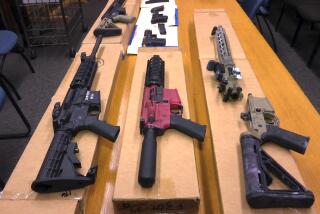Court Backs U.S. on Lower Standards for Car Bumpers
- Share via
WASHINGTON — In a victory for automobile manufacturers, the U.S. Court of Appeals ruled Tuesday that the Reagan Administration was not “arbitrary or capricious” when it lowered impact standards for car bumpers.
The court, in a 2-1 decision, found that the National Highway Traffic Safety Administration followed proper legal procedures in 1982 when it repealed an auto safety rule that had forced auto makers to equip new cars with bumpers that could withstand crashes of 5 m.p.h. The repeal reduced the 5-m.p.h. impact requirement to 2.5 m.p.h., thus allowing manufacturers to use cheaper materials in their bumpers.
The Administration’s action, designed to aid the financially ailing automobile industry, has been under attack from an unlikely alliance of consumer groups, insurance companies and members of Congress.
The court’s ruling further angered these groups, which argue that weaker bumpers mean unsafe cars and higher costs to consumers in repairs, insurance rates and lost time.
Sen. John C. Danforth (R-Mo.), calling the ruling “a bad result,” said the weaker bumpers “are purely ornamental and convert simple parking-lot bumps into $300 repair jobs.”
Danforth, who tried unsuccessfully last year to pass legislation restoring the 5-m.p.h. standard, said he hopes that Congress will “overrule” the court decision “or that American car buyers will insist on bumpers that work.” The senator may reintroduce the legislation again this year.
At the Center for Auto Safety, which had precipitated the ruling by challenging the Administration’s repeal, director Clarence M. Ditlow bluntly termed the court’s decision “a consumer disaster.”
“In reality, we should have 10-m.p.h. bumpers, and here we are arguing over 2.5 or 5 m.p.h.,” Ditlow said.
And James F. Fitzpatrick, counsel for State Farm Insurance Co., which also had appealed the Administration move, said the decision “leaves the average motorist with eggshell protection in the front and rear of the car.”
Nonetheless, Fitzpatrick said 100 million cars have been produced with 5-m.p.h bumpers, saving consumers $1 billion a year in costs arising from accidents.
Noting technological breakthroughs in the automobile industry, he said: “We are reaching a point when the technology can give you stronger bumpers (at a reasonable cost), and we’re going in the other direction.”
At General Motors Corp. in Detroit, Stan Hall, manager of product publicity, hailed the court decision and said the old rules requiring 5-m.p.h. bumpers were not “cost effective for the customer.”
But Ford Motor Co. has stuck with the 5-m.p.h. standard, said Jerald F. terHorst, spokesman for the company’s Washington office, because it “gives our customers an added degree of safety.”






